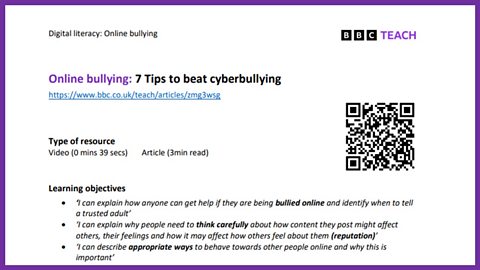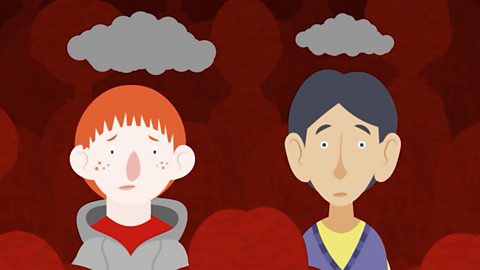Video Summary
A short video where Dr Aaron offers advice on what you should do if you are being cyber-bullied
Article summary
This article gives an explanation of what cyber-bullying is, why it happens, and what it feels like to be cyber-bullied.
Why does it happen?
People often bully because they are going through a tough time themselves. They may take out their problems on others because itÔÇÖs the only way they know how to get control of their own difficult feelings ÔÇô but this is always at someone elseÔÇÖs expense. When bullies are struggling themselves, they also need help and support.
Going online can make it easier to bully because the bully can have a feeling of safe distance that lets them say and do things they probably wouldnÔÇÖt do face to face. They are also protected from seeing how hurt it makes the other person feel.
How does it feel?
Cyberbullying can be upsetting and scary, and can cause all sorts of negative emotions. Because it happens on your phone, tablet or computer, it can feel like a complete invasion, even when youÔÇÖre in a normally safe place like your bedroom.
Being bullied can cause people to do things they wouldnÔÇÖt normally do such as hurting themselves or running away because theyÔÇÖre scared or donÔÇÖt know how to stop it.
How to deal with cyberbullying?
No-one has the right to make you feel threatened or upset. Here are some tips for taking action if it happens:
- DonÔÇÖt reply to upsetting or hurtful messages, no matter how angry they make you feel.
- Try to block the people sending them if possible. Check your network, social media platform or phone provider's help pages for how to do this.
- Keep a log of messages or texts. Take screenshots. DonÔÇÖt delete anything. This will help when explaining whatÔÇÖs happening to you.
- You donÔÇÖt have to deal with the bullying on your own. Talk to an adult you trust ÔÇô a parent or guardian, a teacher, or counsellor.
- If the bullying is happening on a website, social media site or online game, report it. Most sites and services have advice on how to do this in their online help centre.
- Stay in control of your information. Check privacy settings, and keep your details private.
- The worst thing a bully can do is get inside your head. DonÔÇÖt talk to yourself with the voice of a bully, and donÔÇÖt believe what bullies say about you. ThatÔÇÖs how they win. Talk over your feelings with someone you trust.
Am I a cyberbully?
ItÔÇÖs quite easy to get drawn into something that seems like a joke but can make someone else feel embarrassed, left out or humiliated. ÔÇśLikingÔÇÖ something negative about someone or sharing embarrassing photos and videos can become a way to gang up on that person.
If in doubt, check it out. Send the person a private message to ask them if they feel okay about something. If they donÔÇÖt, take it down.
Think about how it would make you feel if it happened to you. We all make mistakes but itÔÇÖs important to learn from them, delete negative posts or comments, and apologise. Next time you post, think about how it could make someone else feel.
Video: 39 secs Article: 3 min read
Learning objectives
(from the set out by the UK Council for Internet Safety)
'I can explain how anyone can get help if they are being bullied online and identify when to tell a trusted adultÔÇÖ
ÔÇśI can explain why people need to think carefully about how content they post might affect others, their feelings and how it may affect how others feel about them (reputation)ÔÇÖ
ÔÇśI can describe appropriate ways to behave towards other people online and why this is importantÔÇÖ
Glossary
- Humiliate: to make someone feel ashamed or foolish
- Expense: with someone as a victim
- Guardian: someone who looks after a child, usually an alternative to a parent
- Privacy Settings: the controls available to determine how much of your personal information is visible to wider networks
Topic introductions and starters
Before the video:
- Ask pupils to work in pairs and write down a definition of cyberbullying and one way to beat it
After the video:
- After reading the article together look back at the definitions written before and check that they match ÔÇô construct a class definition that everyone understands
- Check understanding of any new vocabulary of key terms: humiliate; expense; negative; phone provider; guardian; privacy settings
- Use paper speech bubbles to collect anonymous statements about pupilÔÇÖs own experiencesÔÇô display or go through together ÔÇô donÔÇÖt try and solve, just share the experiences
- Look at the main headings of the article and summarise the content in just one sentence ÔÇô decide what is the key point being made in that section
- Compare the feeling of a someone who is being bullied and the bully themselves ÔÇô make a comparison table or list. Are there similarities?
Discussion Points
Why do bullies bully? Talk about some of the reasons that might include: feeling insecure, feeling unpopular, wanting to makefriends by impressing them
Is it easier to bully online rather than in real life? Is this because the bully doesnÔÇÖt have to see your face or deal with your feelings? Does anonymity make it easier?
Does telling someone actually make the bullying worse? How does getting support make YOU feel?
How can you stop being part of a bullying group? Peer pressure is powerful and might make you join in to stay part of the group. How can you feel strong enough to say no?
How does the cyberbully get into your head? How can you stop this from happening? Who can help you do this? How can you work on feeling more confident and good about yourself?
Fillers and fast finisher activities
- Reduce each of the five article sections to 10 words, then keep removing words until you have one key word to stand for the section ÔÇô eg humiliate, control, scared, ignore, apologise
- Create a catchy slogan that covers the seven ways suggested for dealing with cyberbullying ÔÇô ignore them; block them; keep evidence; talk to someone, report it; stay private; donÔÇÖt believe what they say
- Create a help guide for someone who has been drawn into bullying ÔÇô use a bullet point list of ways they can stop and make amends to anyone they have been bullying
- Make a mind map with Cyberbully at the centre ÔÇô add in all the reasons why someone might get drawn into being part of cyberbullying group
Signposting potential homework activities
- Create an illustrated leaflet or poster showing the seven top tips for dealing with Cyberbullying ÔÇô use one sentence summaries of each suggestion
- Share the article with friends and family and talk about the content together
- Write a script for a role play where someone confesses to being a bully and asks a friend for advice.
For download/printing

More on: Managing online information
How to spot a troll. video
Spoken word artists share their experiences of online safety, to help deal with trolls, clickbait and scams.

Why do people bully? video
An animated video with voiceovers from children reading statements about why people might start behaving like a bully.

Are you being cyberbullied? video
A video about a girl called Abbie, who is being bullied online.
